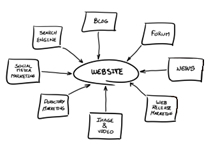Archive for the ‘Web Development’ Category
Description of ‘Web Development’ Category:
Posts dealing with creating content for the World Wide Web, usually websites and webpages using HTML and CSS.
Friday, September 17th, 2010
Hello and welcome to the Internet Beacon! We’re an SEO firm in Maryland.
Apple and Adobe‘s feud has been appearing in the press more and more lately. These two industry giants are poised to start one of the next great IT wars. If you don’t know what’s going on, let me explain. Apple is pushing for HTML5, the open standard for the Web to be ratified by the W3C, the body that governs Internet coding standards, to be the way coders create exciting new content. Adobe, owners of Flash, among other things, are arguing that Flash is integral to the Web and Apple needs to build its devices to work with it. Here are some arguments for both sides:
HTML5
HTML5 will be the standard in approximately 2012, when it is ratified by the W3C. Pages are currently coded in a mix of many languages with a myriad of plug-ins. Proponents of HTML5 are arguing that it will be able to deliver all that we use now, but with one single language. This will make coding easier and require less powerful machines. This all sounds great. However, there is a downside. Programmers who have built their careers using plug-ins like Adobe Flash will have to learn a whole new language if they want to stay employed and relevant. This could create a crisis for web design.
Apple is arguing that since this will be the adopted standard, that it is time to set aside plug-ins and use a unified language.
Adobe Flash
Flash has been the “go to” for creating powerful and creative web content for years now. Taking many forms over the years, Flash has definitely woven it’s way into the fabric of the Web. From simple navigation tools to graphically stunning games and media, Flash is what developers use. The only downside to this is that these programs demand more and more as they grow. Additional bandwidth and more powerful machines are required to experience these items. Think of someone with… Read the rest
Tags: Adobe, Apple, Flash, HTML5, Mobile Web, web
Posted in Browser, Web Development | No Comments »
Thursday, August 26th, 2010
 Hey, Josh here from the Internet Beacon. Hey, Josh here from the Internet Beacon.
So you want to build your own website, eh? It’s hard work. There’s a lot of long hours of study of both the coding language and the programs it takes to manipulate it. There’s a reason professionals do this. However, if you need to throw together something quickly or just want to get your feet wet, here are a few program to try.
Apple iWeb
Bundled in for free with every Mac computer, the iLife suite is a series of software designed to let users start doing things with their computers right from the start. Far from shovelware, there products are quality tools. One of these programs is iWeb. iWeb is a great piece of software that takes away a lot of the need to know HTML, the coding language of websites. You can edit and create sites using templates, or start from scratch and make a site using a graphical user interface (GUI) rather than just text.
Adobe Dreamweaver
The de facto standard in web design, Dreamweaver is Adobe’s solution for building webpages. Be warned, it is not for the faint of heart. While Apple’s iWeb will give you a good tool to get a feel for how basic web design works, Dreamweaver is loaded with add-ons and tools for the professional web designer. If you are not accustomed to how this kind of software works, you may easily end up closing it as soon as you opened it.
Microsoft Expression Studio
The latest web design software from Microsoft, Expression Studio feels like a nice middle ground between iWeb and Dreamweaver. Microsoft claims that it is good for beginners as well as seasoned professionals. This is the only one I have not used personally, so I cannot comment in-depth on this software. All I can do is point you to their site and let you check it out for yourself.
-Josh
Internet Beacon
for More info on SEO, check out our SEO Answers page, our SEO Glossary, and our blog posts on SEO. SEM – Search Engine Marketing in Maryland

Tags: Adobe, Apple, Microsoft, Programming, web, Web design
Posted in Web Development | No Comments »
Thursday, August 5th, 2010
 Hey, Josh here from the InternetBeacon. Hey, Josh here from the InternetBeacon.
More info on SEO, check out our SEO Answers page, our SEO Glossary, and our blog posts on SEO.
Today we examine one of the classic conundrums when it comes to web design: using advertising to grow and earn from you website while not turning your page into a seizure-inducing catastrophe. Fear not, this can be done. In fact, lots of people have done this already. Here are a few tips.
Carefully Examine Potential Ads
Unless you really didn’t look at the agreement before posting ads on your site, you should have had a chance to look at some ads that the company runs. If they are all “Click Here! You’re a Winner!” ads with strobe effects and smiley faces, you will probably want to stay away from them. Be cautious, as your ads will affect how people perceive your site.
Take it Slow
Placing advertisements on your site is not an “all or nothing” deal. You can start slowly and examine how different types of ads work. Google, for example, offers very simple, low-impact ads that will give you a taste of how the ad game works in relation to your site.
Match Ads to Content
Some ad networks will do this for you. You tell them what your site is about and some demographic info and they provide you with ads. However, some may not do this and so you need to make sure the ads on your page make sense. If you are writing a blog about home remedies and your page’s ads are about savings on video games, odds are they won’t match your target market.
-Josh
Internet Beacon

Tags: ads, Blog Hints, seo, site
Posted in Internet Marketing, Web Development | No Comments »
Friday, July 9th, 2010
 Hey, Josh here from the Internet Beacon. We are a Search Engine Optimization (SEO) firm located in Reisterstown, Maryland. What we do, SEO, is a subcategory of Internet Marketing. Similar to traditional advertising, SEO is all about getting your Brand out there. In this case, we´re working to get your website in front of customers through search engines like Google, Yahoo, and Bing. For more quick, useful information, check out our SEO Answers page, our SEO Glossary, and our blog posts on SEO. Hey, Josh here from the Internet Beacon. We are a Search Engine Optimization (SEO) firm located in Reisterstown, Maryland. What we do, SEO, is a subcategory of Internet Marketing. Similar to traditional advertising, SEO is all about getting your Brand out there. In this case, we´re working to get your website in front of customers through search engines like Google, Yahoo, and Bing. For more quick, useful information, check out our SEO Answers page, our SEO Glossary, and our blog posts on SEO.
How do the big search engines see your websites content?
Google, and most search engines, use robots to sort through your page for content. These are not actual robots, but computer programs with a single purpose, to crawl your website. Crawling means taking the time to read all the code that makes up your page. This is largely HTML, but other code like Flash is partially recognized. What is important here is tight design to aid the robots in reading your site. You can also assist them via scripting, but that is something best saved for professionals like your SEO specialist.
Is Flash a factor?
Yes. Google can read a little bit of Flash, but HTML and other standard code is where they get most of their data. Be careful when using Flash, as overuse will result in difficulties with PageRank and other methods of promotion. The same goes with splash pages, or intro pages, for your website. That may have been cool in the 1990s, but today people want to get to your content as soon as possible. There’s no need to make a separate page to welcome them.
How do images come into play?
Without ALT tags for your images search engines won’t know what to do with them. As clever as Google’s robots are, they aren’t discerning all the contents of your pictures. The “ALT” tag allows for users to put captions in the code for their images. This way, if there are visitors to the site who are visually impaired, they will still know what is going on on your page.
-Josh
Internet Beacon

Tags: content, Google, HTML, Internet Marketing, Popularity, Robots, seo
Posted in Search Engine Optimization SEO, Web Development | No Comments »
Wednesday, June 30th, 2010
 Hey, Josh here from the Internet Beacon. We are a Search Engine Optimization (SEO) firm located in Reisterstown, Maryland. What we do, SEO, is a subcategory of Internet Marketing. Similar to traditional advertising, SEO is all about getting your Brand out there. In this case, we´re working to get your website in front of customers through search engines like Google, Yahoo, and Bing. For more quick, useful information, check out our SEO Answers page, our SEO Glossary, and our blog posts on SEO. Hey, Josh here from the Internet Beacon. We are a Search Engine Optimization (SEO) firm located in Reisterstown, Maryland. What we do, SEO, is a subcategory of Internet Marketing. Similar to traditional advertising, SEO is all about getting your Brand out there. In this case, we´re working to get your website in front of customers through search engines like Google, Yahoo, and Bing. For more quick, useful information, check out our SEO Answers page, our SEO Glossary, and our blog posts on SEO.
Building a quality website is no easy task. Certainly there is software to assist the uninitiated in building a home on the Web (like Adobe Dreamweaver), but making sure that the site has value is something entirely different. The temptation exists to make your website big and flashy. However, the site’s quality often suffers as a result. Here are a few things to look out for.
Language
The language you use on your site says a lot about you. This is not limited to only slang, but the tone in which it is written as well as things like grammar and punctuation. Your website is the way the world will see you. Will they see someone who takes the time to make sure what they have makes sense or will they see someone who hurries to get things posted by sacrificing quality. Traffic is important, but repeat clients are what you want. Make sure that the language you use is tailored to your prospective clients.
Images
Images can be a great way to spruce up your site. As the saying goes, “a picture is worth a thousand words.” You can save time and website space by using a picture appropriately. Conversely, if you use too many pictures on your site, it becomes cluttered with a lot of visual noise. Visitors will become frustrated and the loadtimes, even on a highspeed connection, could become unbearable. We’ve all seen pages that jump around a lot because of too many images fighting for their place.
-Josh
Internet Beacon

Tags: Design, internet, Web design, website, Website Building, Website Creation
Posted in Web Development | 1 Comment »
Friday, March 12th, 2010
 Welcome to the Internet Beacon’s blog. My name is Josh. The Internet Beacon is a Search Engine Optimization firm located in Finksburg, MD. SEO is a form of Internet Marketing. In essence, we work with you and your website to increase the likelihood of being found in search engines like Google and Yahoo. For more information, check out our page on SEO Answers and our blog post on SEO. This week I’d like to talk about keeping spammers off of your blog. Welcome to the Internet Beacon’s blog. My name is Josh. The Internet Beacon is a Search Engine Optimization firm located in Finksburg, MD. SEO is a form of Internet Marketing. In essence, we work with you and your website to increase the likelihood of being found in search engines like Google and Yahoo. For more information, check out our page on SEO Answers and our blog post on SEO. This week I’d like to talk about keeping spammers off of your blog.
A blog is a great way to get your particular message out to people around the world. Whether you are sharing recipes, business strategies, or trading baseball cards, a blog can become a hub of activity. Naturally, there are people drawn to these places to take advantage of the amount of activity. These people are called spammers. You can tell who they are because they don’t usually add to the conversation, but rather promote their own site. Keeping these people off of your blog will go a long way towards building its legitimacy. Here are three ways to do that.
1) CAPTCHA Them.
First, please forgive the play on words. Okay, a CAPTCHA is a tool for many
blogs and other sites which requires the user to enter the text they see in an image that looks slightly garbled of distorted. We’ve all seen them. CAPTCHA is used to prevent automated software from just scanning a website and filling in their information. This is a classic method for spammers. The best part of this is that implementation is free and has very little impact on the end user. It is readily available for WordPress as an add-on called “SI CAPTCHA Anti-Spam 2.2.9”. It’s free so go out and grab it if WordPress is powering your blog.
2) Papers Please
Another way to ensure that the comments left on your blog are legitimate is to require users to register themselves. This is an almost surefire way to make sure that comments left are legitimate. The biggest downside here is that many users may not wish… Read the rest
Tags: Blog Hints, captcha, comments, internet, marketing, seo, spammers
Posted in Blog Hints, Internet Marketing, Web Development | 1 Comment »
Friday, October 9th, 2009
Have you ever had trouble with spacing around Header tags?
I sure have.
I finally realized that my CSS sheet settings could fix this.
| As with any HTML tags, just mention the tag in your CSS sheet and settings:
h1,h2,h3,h4 {
margin:0px;
padding:0px;
vertical-align:top;
}
And that was my fix to remove space after a header. |
 |
As with any CSS entry we can also speak to the Header’s font in the style sheet.
h1,h2,h3,h4 {
margin:0px;
padding:0px;
vertical-align:top;
font-family: arial; font-size: 14pt; text-transform: none; color: #000066;
}
Sean
www.internetbeacon.com
Internet Marketing and SEO in Baltimore

Tags: css, css sheet, white space around header
Posted in Web Development | 1 Comment »
|
Three Ways to curb Spam on Your Blog
Friday, March 12th, 2010A blog is a great way to get your particular message out to people around the world. Whether you are sharing recipes, business strategies, or trading baseball cards, a blog can become a hub of activity. Naturally, there are people drawn to these places to take advantage of the amount of activity. These people are called spammers. You can tell who they are because they don’t usually add to the conversation, but rather promote their own site. Keeping these people off of your blog will go a long way towards building its legitimacy. Here are three ways to do that.
1) CAPTCHA Them.
First, please forgive the play on words. Okay, a CAPTCHA is a tool for many
blogs and other sites which requires the user to enter the text they see in an image that looks slightly garbled of distorted. We’ve all seen them. CAPTCHA is used to prevent automated software from just scanning a website and filling in their information. This is a classic method for spammers. The best part of this is that implementation is free and has very little impact on the end user. It is readily available for WordPress as an add-on called “SI CAPTCHA Anti-Spam 2.2.9”. It’s free so go out and grab it if WordPress is powering your blog.
2) Papers Please
Another way to ensure that the comments left on your blog are legitimate is to require users to register themselves. This is an almost surefire way to make sure that comments left are legitimate. The biggest downside here is that many users may not wish… Read the rest
Tags: Blog Hints, captcha, comments, internet, marketing, seo, spammers
Posted in Blog Hints, Internet Marketing, Web Development | 1 Comment »